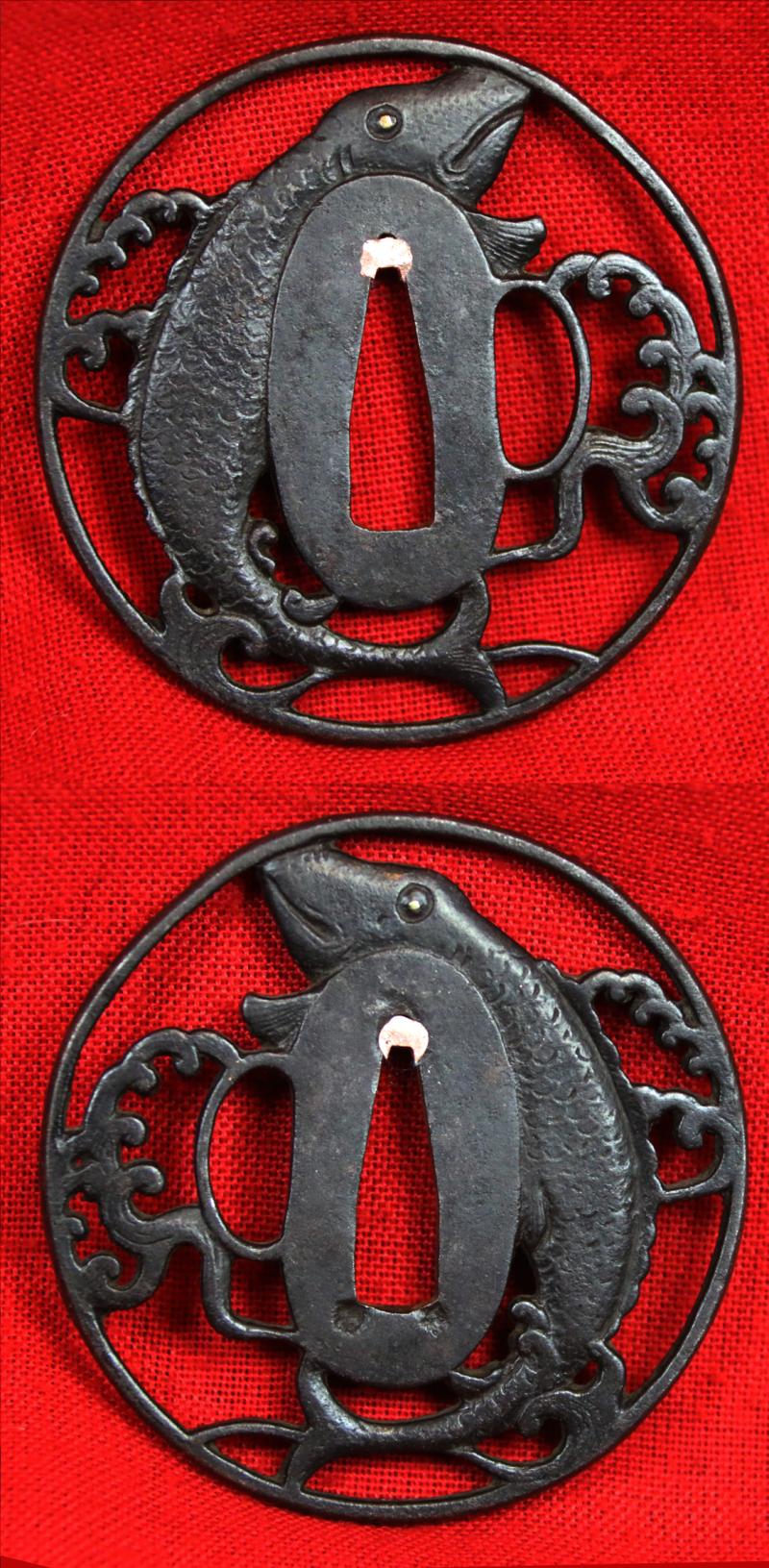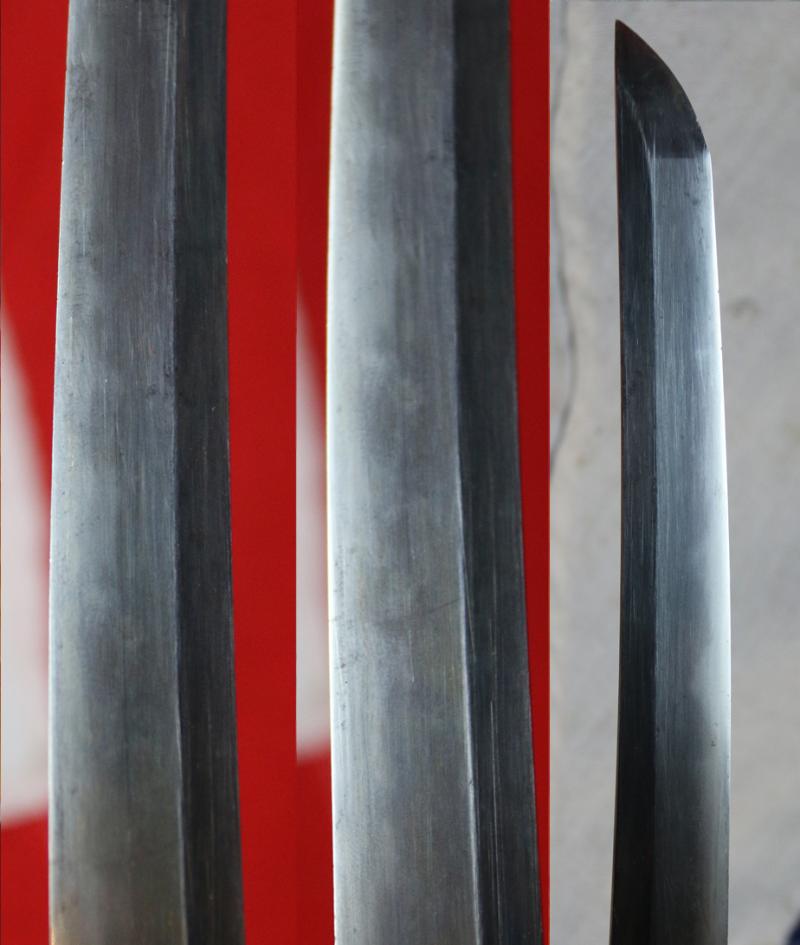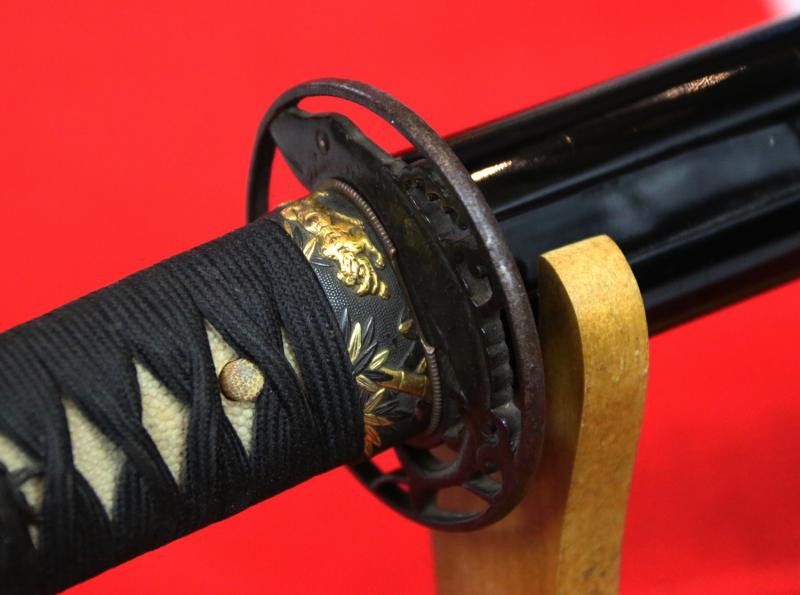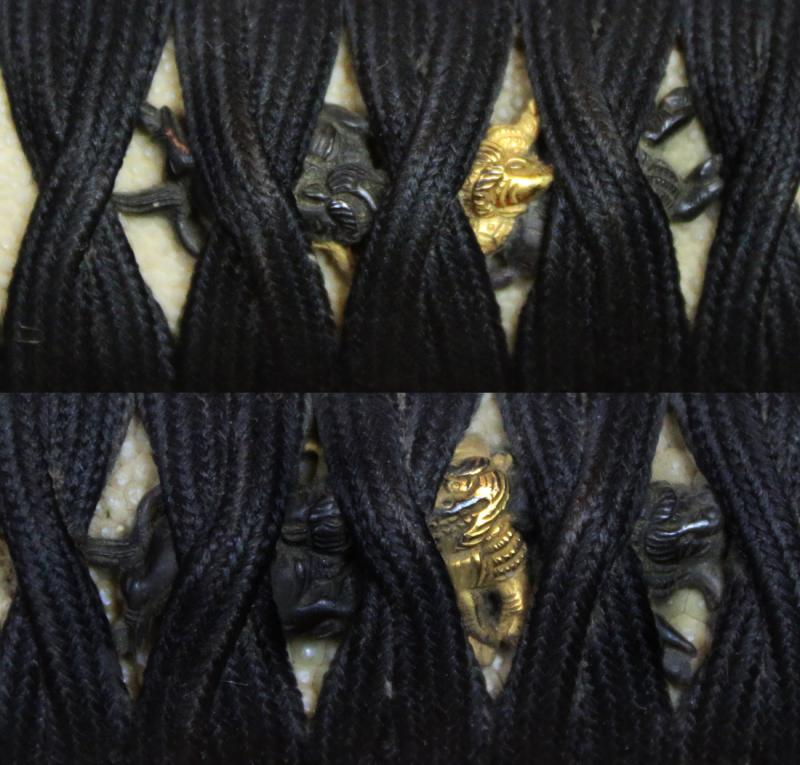Most Handsome Koto Period, Circa 1500, Samurai Chisa Katana With an Edo Shoami Sukashi Tsuba Of a Leaping Koi Carp in White Water, With A Very Beautiful Quality Fuchi of a Tiger in a Bamboo Grove of Pure Gold Onlaid Shakudo
An original Koto period samurai sword with fine quality original Edo period fuchigashira of pure gold onlaid shakudo of a takebori lion within a gold leaved bamboo grove, on a hand punched nanako ground, and menuki with gold decorated flowers and birds, a jumping fish o sukashi tsuba of delightful quality pierced o-sukashi tsuba in iron, with matching gold and shakudo takebori tigers in combat menuki. A lightly stippled finish shakudo kashira.
Original antique Edo fittings and nurizaya roiro-nuri (蝋色塗, wax colour coating): glossy, mirror-like finish saya, with kozuka and kogai pockets.
A "Nurizaya" (塗鞘) is a scabbard that has been lacquered. The process of lacquering a scabbard involves applying lacquer, letting it dry, and then polishing it, repeating these steps multiple times.
The lacquering is done by a craftsman known as "Nushi" or "Nurishi" (塗師), and it varies depending on the craftsman. The process starts with applying raw lacquer to solidify the hand carved wooden base, followed by applying an undercoat, thenmany layers of black lacquer {or other colours}, and finally, a top coat to complete the Nurizaya. The entire process in the Edo period and before, to bespoke create this saya, with hand carved buffalo fittings and mounts {such as the kurikata, kojiri, koiguchi kaeshizuno {返し角 hook-shaped fitting used to lock the saya to the obi while drawing the sword from the saya}. And then, lacquer can take a year or more, due to each single layer of urushi lacquer taking a month to dry and cure, and there can be up to 12 layers of lacquer per saya.
A katana was two shaku or longer in length (one shaku = about 11.93 inches). However, the Chisa katana is longer than the wakizashi, which was somewhere in between one and two shaku in length. The most common blade lengths for Chisa katana was approximately eighteen to twenty-four inches. They were most commonly made in the Buke-Zukuri mounting (which is generally what is seen on katana and wakizashi). The chisa katana was able to be used with one or even two hands like a katana. The Chisa Katana is a slightly shorter Katana highly suitable for two handed, or two sword combat, or, combat within enclosed areas such as castles or buildings. As such they were often the sword of choice for the personal Samurai guard of a Daimyo, and generally the only warriors permitted to be armed in his presence. Chisa katana, Chiisagatana or literally "short katana", are shoto mounted as katana.
The chisa katana was also the long sword of choice for the art of twin sword combat, using two at once in unison, a chisa katana and wakazashi, one in each hand, a form used by the great and legendary samurai Miyamoto Musashi who reportedly killed 60 men before his 30th birthday.
Miyamoto Musashi 1584 – June 13, 1645), also known as Shinmen Takezo, Miyamoto Bennosuke or, by his Buddhist name, Niten Doraku, was an expert Japanese swordsman and ronin. Musashi, as he was often simply known, became renowned through stories of his excellent, and unique double bladed swordsmanship and undefeated record in his 60 duels. He was the founder of the Hyoho Niten Ichi-ryu or Niten-ryu style of swordsmanship and in his final years authored the The Book of Five Rings, a book on strategy, tactics, and philosophy that is still studied today. inch blade tsuba to tip. inches long overall
Every single item from The Lanes Armoury is accompanied by our unique Certificate of Authenticity. Part of our continued dedication to maintain the standards forged by us over the past 100 years of our family’s trading, as Britain’s oldest established, and favourite, armoury and gallery.
THE LANES ARMOURY, THE PREMIER HOME OF ORIGINAL AND AFFORDABLE ANCIENT ANTIQUITIES & MILITARY ANTIQUE COLLECTABLES IN BRITAIN.
The Lanes Armoury, is world renown as Britain's favourite specialist collectors shop, and also a font of historical and educational information that is detailed with every single item. We detail each piece alongside its historical context, either generic or specific, for those that may wish to read, learn, or be informed, as opposed to simply acquire collectable items. We are probably one of the oldest companies of our kind in the whole of Europe and we have been established through generations, as specialists in armoury, military antiques, militaria collectables, and specialist books, since the early 1900’s, and thus we have continued to be one of the largest in the world today. The current partners were set on this path by their great grandfather, who while intrigued by historic antique arms and armour, was woefully under capitalised for his dream profession, so much so that even when starting his very small business, just after the first world war, he still kept up his original working class pre war trade as a scaffolder as his safety net in case his dreams folded. Just as well for his succeeding generations, he didn’t fail. However, true to his very old-fashioned working class ethics, every subsequent generation had to follow their own path, with no financial assistance whatsoever, with his son, grandson and great-grandsons having to make their own way, on their own skill and merits, whatever they may be.
We are also very pleased to know we are also studied and read by academics and students from hundreds of universities around the world, by those that are interested in not only British but worldwide history. Of course we are not perfect and errors can and will be made, but thanks to our viewers and visitors, errors can be corrected, and learnt from.
Our sacred principle is that every single country's history ought to be studied, and passed down, however good, or bad some of it may be. All history is knowledge, good, bad or indifferent.
Everyday we are contacted by historians that wish to make contributions to our detailed information for our pieces, and to thus add to our constant dedication to impart historical knowledge, that may be unknown to many of our millions of viewers.
As once told to us by an esteemed regular visitor to us here in our gallery, in order to view and study our Japanese edged weapons and armour gallery, and the same words that are repeated in his book;
“In these textures lies an extraordinary and unique feature of the sword - the steel itself possesses an intrinsic beauty. The Japanese sword has been appreciated as an art object since its perfection some time during the tenth century AD. Fine swords have been more highly prized than lands or riches, those of superior quality being handed down from generation to generation. In fact, many well-documented swords, whose blades are signed by their makers, survive from nearly a thousand years ago. Recognizable features of the blades of hundreds of schools of sword-making have been punctiliously recorded, and the study of the sword is a guide to the flow of Japanese history.”
Victor Harris
Curator, Assistant Keeper and then Keeper (1998-2003) of the Department of Japanese Antiquities at the British Museum. He studied from 1968-71 under Sato Kenzan, Tokyo National Museum and Society for the Preservation of Japanese Swords
Overall in great condition. The blade bears some light surface scratches so we will have this attended to it should be finished by the end of June
Code: 25790
4450.00 GBP









